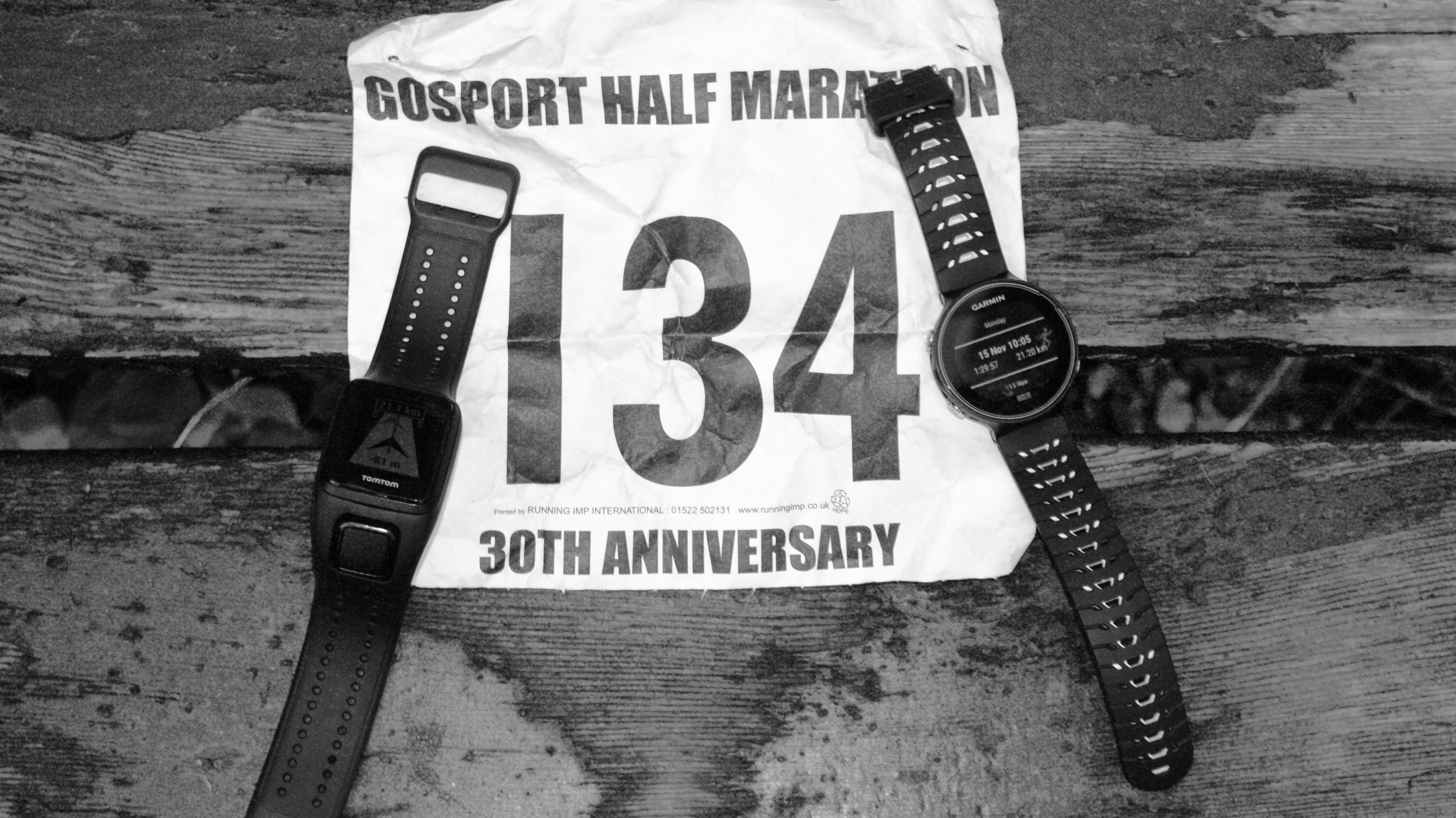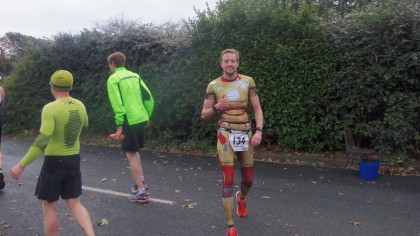Garmin Forerunner 630 vs TomTom Spark: the half marathon test
Which can help you go the fastest?

Before we start: this is a real life comparison in a race environment. It's not stress testing each device - it's working out which features I gravitated towards while trying to run as fast as possible. I'll do a more in-depth look later on, but just wanted to set out the stall before you began reading.
The comparison: Garmin's new Forerunner 630 costs £389 / $450 / around AU$630 (with the necessary heart rate monitor to get the most out of it), and it can track everything from sleep and steps to all the normal running metrics as well as advanced stuff like which foot is more dominant and theoretical maximum speeds.
The TomTom Spark comes in at a cheaper £150 / $249 /AU$349, but sticks with a rectangular monochrome screen - it's lower res, but doesn't really impact on the functionality of the device. The main win here is that the Spark offers Bluetooth playback, where MP3s stored on the watch can be streamed right to your ears without the need for a smartphone.
It's also got an inbuilt heart rate monitor, firing light under the skin to measure your pulse. It can take a while to get a reading (as it did here) but once it's worked out your rhythm, it's pretty good.
The two are two different devices, with the Forerunner 630 more advanced in its functionality (and therefore more expensive) and the Spark more of an entry level device - although one that can track swimming, running and cycling.
Let's get running
The test here was simple: run the Gosport Half Marathon faster than last year. I'll set the scene: this race is beautifully flat, run along the promenade of my home town. It's renowned for a) being a great PB race, given the lack of elevation, and b) being really rather cold thanks to being run in November.
The cold wasn't the issue this year - my word, it was windy. I managed about 91 and a half minutes in 2014, and I really wanted to beat that time. The blustering was going to make that tricky.
Get daily insight, inspiration and deals in your inbox
Sign up for breaking news, reviews, opinion, top tech deals, and more.
It's also an 'open road' race, which means headphones are banned - it would be too dangerous if you couldn't hear cars coming or marshall instructions. Therefore the TomTom Spark's abilities were a little limited, which was a real shame.

Here was the first test: which watch would structure my race the best? Being able to pace yourself is a key element, and both have good systems. The Spark lets you choose a race distance and a time so you can pace against it - Garmin does the same, but you can also download a previous race and run against yourself… although doing this on the Garmin Connect website proved to be a very, very difficult task.
Anyway, the gun went off (well, a man with a klaxon) and we were off. I looked down at the Garmin, and it told me I was '89 minutes behind last year'... well, something had corrupted there. Clearly it wanted the same watch to work properly.
This was particularly irritating as I'd been banking on being able to race myself exactly - the benefit of using this Garmin function is that if you're slower at the start and fast at the end, you'll be matched against that rather than an average pace.
With that lost, I decided to switch to the performance metrics on offer: being able to see which foot I was using more dominantly, work out my performance levels or just keep an eye on my heart rate.
But back to the start, and the TomTom, in 'average pace' mode was working nicely. The start straight saw it bleep and tell me I was in second place compared to the average pace (a nice touch that helps motivate) and a few strides later I was back in front.
Then came the tricky bit: trying to gain as much time as I could while shielded from the wind, as it was going to ruin my race otherwise. I pushed for the first three kilometres, watching the distance ahead rise to 128 metres.
The Garmin, on the other hand, was proving to be a little less useful now the virtual race function was down. The Performance Condition function, which uses your heart rate variability (the difference in beat rhythms) to decide how well you're performing and how much is left in the tank. I was told I was at +3 at the start, where I think it goes up to +10.
That wasn't enough, and a few km later it had dropped to -1 - I was hoping that this was just because it was a new watch and hadn't calibrated my 'fuel tank' yet, as otherwise I wasn't even going to finish this race, let alone beat my time.
I also found that skipping through the screens was a right ball-ache, simply because I needed to push the touchscreen quite hard, rather than tapping the buttons on the side like with the Forerunner 920XT I usually use.
Get me to the end, please
The good news is the heart rate seemed to be pretty accurate, with both devices noting I was pushing up to around the 170bpm mark. Not bad for the roughly 4:10 minutes per km I was going at, so I was pretty chirpy.
The TomTom isn't much use at working out your personal heart rate zones, so using the function that tells you if you're warming up, running easily or really hard didn't quite correlate - so I kept it on the race pace screen, which, at halfway, told me I was nearly 300m up on last year.
The second half of the race was typified by one thing: wind. And no, not because I was breaking it, you immature fool.

The 'out and back' nature of this race meant that the return leg, with less wind, allowed me to recover a bit, but nothing prepared me for slogging it through the wind for 3 and a bit miles again. It was torture, watching my speed drain away and the average pace on the Spark dropping fast.
I watched the Garmin tell me my pulse was shooting up and my pace each kilometre was dropping. I just did what I could, gritted my teeth and hoped for the turning point to come soon.
The run back was fairly uneventful, but both watches came into their own here. My pulse dropped to 165bpm, so I knew I had more in the tank - Garmin's alerts are a little more focused here, and are a good motivation.
The last 5 kilometres were hard, but I managed to push on a bit to use that extra pace in the tank and keep my heart rate up. One of the key elements of the 630 is its ability to work out your 'lactate threshold pace', the pace and heart rate I can push at before exploding, and that hasn't been generated yet… but I reckon it'll be about 172bpm and 4:08 min per km.
A sprint finish later and I was told by both watches that I'd beaten my time - the predicted race time was still working on the Forerunner, it seems, even if racing my past self throughout was not.
However, the Garmin had been a bit generous in tracking, telling me I'd done about 150m more than I had, where the TomTom was pretty consistent. The bigger disparity here was the battery life though - the TomTom was dead a few minutes after the end of the race (although in fairness I'd had the backlight on the entire time).
The Garmin Forerunner 630 was still going very strongly though, with only about 25% lost at the most - hugely impressive. In fact, subsequent tests have shown me that this thing can go for about a week even with a run every day - immense.
The TomTom Spark is a splendid watch and great for the newer runner - it's a lot cheaper and the amount of stuff in there - heart rate monitor, Bluetooth music playback and race guidance - impresses me a lot.
But once the Forerunner 630 has 'learned me' and the key metrics have dialled in on the Forerunner 630 I think I'd prefer that as a watch for racing - the ability to fine tune your race is amazing, although it's so annoying that downloading a previous race doesn't work well enough. Plus I'm never going to be a fan of using a touchscreen during a race.
However, battery life is really important, and the 630 has that in spades - but the great news is, both are excellent choices, and it just depends how much you want to spend.
- Gareth Beavis is TechRadar's Running Man of Tech, testing the latest in fitness technology in a never-ending quest to run further and faster and bringing you the results in a weekly column. If you want to say hi, he's @superbeav on Twitter, and you can see his stumblings on Strava too... plus for more data, follow him on Smashrun - if you want to sign up, please use this link (once you see the service, you'll work out why...)
- And if you want to get the full lowdown on the latest and greatest running tech, read the rest of the Running Man of Tech story here.

Gareth has been part of the consumer technology world in a career spanning three decades. He started life as a staff writer on the fledgling TechRadar, and has grew with the site (primarily as phones, tablets and wearables editor) until becoming Global Editor in Chief in 2018. Gareth has written over 4,000 articles for TechRadar, has contributed expert insight to a number of other publications, chaired panels on zeitgeist technologies, presented at the Gadget Show Live as well as representing the brand on TV and radio for multiple channels including Sky, BBC, ITV and Al-Jazeera. Passionate about fitness, he can bore anyone rigid about stress management, sleep tracking, heart rate variance as well as bemoaning something about the latest iPhone, Galaxy or OLED TV.